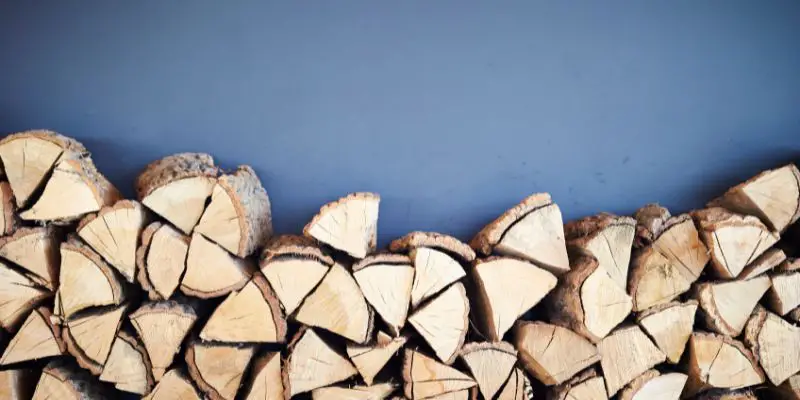Yes, walnut is good firewood due to its high heating value and long burning time. It is dense and produces a steady, consistent heat making it ideal for keeping warm.
Known for its rich, earthy flavor, walnuts are a popular choice for cooking and baking. However, they also serve another purpose – as firewood. Walnut wood is dense and compact, which means it burns slowly and efficiently, producing a high amount of heat.
With a heating value similar to oak, walnut firewood is ideal for those chilly winter nights when you need to keep your home warm and cozy. Moreover, it provides a steady, consistent heat that can last longer compared to other types of firewood. So, if you have access to walnut wood, it can be a great option for a reliable and efficient source of heat.
Benefits Of Walnut Firewood
Walnut firewood is an excellent option for heating due to its high energy content and pleasant aroma. It produces long-lasting, intense heat, making it ideal for fireplace use. Additionally, walnut firewood generates minimal ash, making cleanup a breeze.
When it comes to choosing firewood for your fireplace or wood-burning stove, it’s important to consider the benefits of walnut firewood. Walnut firewood is known for its high heat output and long burning time, making it an excellent choice for keeping your home warm and cozy during the colder months.
High Heat Output
One of the main benefits of walnut firewood is its high heat output. Walnut wood is dense and heavy, which means it burns hotter and produces more heat compared to other types of firewood. This makes it highly efficient for heating large spaces or maintaining a comfortable temperature throughout your home. With walnut firewood, you can be sure that you’ll stay warm even on the coldest winter nights.
Long Burning Time
Another advantage of walnut firewood is its long burning time. Due to its density, walnut wood burns slowly and steadily, providing a steady source of heat for an extended period. This means you won’t have to constantly tend to the fire, adding more wood frequently. With walnut firewood, you can enjoy longer intervals between having to add more logs, allowing you to relax and enjoy the warmth without interruption.
Best Practices For Using Walnut Firewood
When it comes to using walnut firewood, there are a few best practices that you should keep in mind. Proper seasoning and drying, as well as correct stacking and storage, are crucial for ensuring the optimal performance of walnut firewood. In this section, we will delve into these practices and provide you with the necessary information to get the most out of your walnut firewood.
Seasoning And Drying
Seasoning and drying the walnut firewood properly is vital to achieve an efficient and long-lasting burn. Walnut wood contains a high amount of moisture, and burning it while it’s still wet can result in excessive smoke, poor heat output, and increased creosote buildup in your chimney. To ensure proper seasoning and drying, follow these steps:
- Cut the walnut logs into smaller pieces, approximately 16 inches in length, to speed up the drying process.
- Split the logs to expose the inner wood, which will allow for better airflow and quicker moisture evaporation. This can be done using a log splitter or axe.
- Stack the split logs in a single row with sufficient space between each piece to allow for air circulation.
- Elevate the stacked wood off the ground using pallets or other suitable materials to prevent moisture absorption from the soil.
- Ensure the woodpile is placed in a well-ventilated area, protected from rain and snow but exposed to natural airflow.
Proper Stacking And Storage
Once the walnut firewood is properly seasoned and dried, it is crucial to stack and store it correctly to maintain its quality and allow for easy access when needed. Follow these guidelines:
- Stack the wood in a sturdy and stable manner, preferably in a woodshed or covered storage area.
- Use a rack or build a stack that allows for proper airflow between the logs.
- Avoid stacking the wood too tightly, as this can impede airflow, leading to potential mold or rot issues.
- Keep the stack away from the walls and corners to prevent moisture accumulation.
- Regularly inspect the woodpile for signs of insects or rot and promptly remove any affected pieces.
By following these best practices, you can ensure that your walnut firewood is well-seasoned, properly dried, and stored in optimal conditions, resulting in a more enjoyable and efficient firewood experience. Remember, taking the necessary steps to care for your walnut firewood will ultimately enhance its performance and longevity.
Potential Concerns With Walnut Firewood
When using walnut firewood, there are potential concerns that need to be considered to ensure the safety and integrity of your fireplace and chimney. Understanding these potential concerns can help you make informed decisions about using walnut firewood. Here are some of the primary concerns associated with walnut firewood:
Creosote Build-up
Walnut firewood can produce a higher amount of creosote compared to other types of firewood. Creosote is a flammable byproduct of wood combustion that can accumulate in the chimney. A high build-up of creosote can increase the risk of chimney fires, posing a significant safety hazard. It is essential to monitor and regularly clean the chimney when using walnut firewood to prevent creosote build-up.
Impact On Chimney Health
The use of walnut firewood may impact the overall health of your chimney. The high levels of creosote produced by burning walnut wood can lead to the deterioration of the chimney’s internal lining. This can compromise the structural integrity of the chimney over time, leading to costly repairs. Regular inspections and maintenance are necessary to address any potential damage caused by the use of walnut firewood.
In summary, while walnut firewood can provide warmth and ambiance, it is important to be aware of the potential concerns it may present. Taking proactive measures to address creosote build-up and chimney health can help mitigate the risks associated with using walnut firewood as a fuel source.
Environmental Impact Of Using Walnut Firewood
Using walnut firewood not only provides warmth and a cozy atmosphere during cold winter nights, but it also offers several environmental benefits. By understanding the renewable resource aspect and the carbon footprint of using walnut firewood, you can make an informed decision that is both sustainable and environmentally friendly.
Renewable Resource
Walnut firewood is a renewable resource that can be sustainably harvested. As trees are cut down for firewood, new trees can be planted to replenish the supply. This process ensures that the availability of walnut firewood remains stable without depleting natural resources. By opting for walnut firewood, you contribute to the preservation of forests while keeping yourself warm and comfortable.
Carbon Footprint
When it comes to the carbon footprint, walnut firewood has a notable advantage. Burning wood releases carbon dioxide into the atmosphere, contributing to greenhouse gas emissions. However, compared to fossil fuels such as coal or oil, burning walnut firewood has a smaller carbon footprint.
Walnut firewood is considered a carbon-neutral fuel because the carbon dioxide released during combustion is roughly equal to the amount absorbed by the walnut trees during their growth. This balance helps in reducing the overall carbon footprint of using walnut firewood as compared to using non-renewable fuels.
Additionally, using walnut firewood can be a more sustainable alternative to electric or gas heating systems that rely on non-renewable energy sources. By choosing walnut firewood, you actively reduce your reliance on fossil fuels and contribute to a cleaner and greener environment.
Conclusion And Considerations
Walnut firewood offers excellent heat output and a pleasant aroma when burned. It is a popular choice due to its long burning time and minimal smoke production, making it a good option for heating purposes. Considerations should be given to proper seasoning and storage to optimize its burning efficiency.
Choosing walnut firewood, like any other firewood, requires careful consideration of its advantages and challenges. By reviewing the key aspects of this firewood option, you can make an informed decision that suits your needs and preferences.
Choosing Walnut Firewood Wisely
When selecting walnut firewood, it is important to keep a few factors in mind. Firstly, ensure that you obtain the firewood from a reputable source or supplier. This ensures the wood is properly seasoned, reducing the moisture content and ensuring optimal burning efficiency. Additionally, properly seasoned walnut firewood reduces the risk of excessive smoke and creosote buildup, which can be harmful to your health and cause chimney fires.
Furthermore, consider the size and quality of the walnut firewood you choose. Opt for well-cut logs that are of uniform size, as this promotes consistent burning and heat output. Avoid using oversized or undersized pieces, as they can affect the airflow within your fireplace or wood-burning stove. Remember that properly sized walnut firewood, when burned, produces a pleasant aroma resembling the scent of nuts, adding to the overall ambiance of your home.
Balancing Benefits And Challenges
While walnut firewood offers numerous benefits, it is essential to balance them with the challenges it may present. One of the notable challenges with walnut firewood is its tendency to produce more ash compared to other firewood types. Regular cleaning of your fireplace or stove becomes necessary to maintain proper functioning and efficiency.
Another consideration is the potential for a slower burn rate with walnut firewood. This means you may need to add more logs to your fire to maintain the desired warmth. However, the upside to this is that walnut firewood provides longer-lasting heat, making it ideal for colder nights when you want a sustained source of warmth.
In conclusion, choosing walnut firewood involves weighing the benefits and challenges it brings. By sourcing the firewood from a reputable supplier and considering its size and quality, you can ensure a pleasurable and efficient burning experience. Despite the additional ash produced and slightly slower burn rate, walnut firewood offers a unique nutty aroma and a sustained, comforting heat. So, if you are seeking a firewood option that is both functional and aromatic, walnut firewood may be the perfect choice for you.

Frequently Asked Questions Of Is Walnut Good Firewood
Is Walnut A Good Wood To Burn In A Fireplace?
Yes, walnut is a good wood to burn in a fireplace. It produces long-lasting and even heat with a pleasant aroma. However, it is important to properly season the wood and ensure it is dry before burning it in the fireplace.
How Long To Season Walnut Firewood?
To season walnut firewood, it typically takes 6-12 months in a dry, well-ventilated area. Properly seasoned firewood has a moisture content of 20% or less, ensuring efficient burning and reduced creosote buildup. Regularly test the moisture levels using a wood moisture meter for best results.
What Are The Disadvantages Of Walnut Wood?
The disadvantages of walnut wood include its high cost, susceptibility to water damage, and tendency to darken over time. It can be difficult to work with due to its hardness, and its dark color may not suit all aesthetic preferences.
Proper maintenance and precautions are necessary to avoid warping or bending.
Is Oak Or Walnut Firewood Better?
Oak firewood is a better choice for burning because it produces more heat and burns longer than walnut firewood. Oak firewood also creates a nice aroma and leaves minimal ash.
Conclusion
To sum up, walnuts can be a great option for firewood due to their high energy output, pleasant aroma, and easy handling. It burns hot and long, making it suitable for heating and cooking. With proper seasoning, walnut can be an efficient choice for your fireplace or wood-burning stove.
Consider adding walnut to your firewood collection for a cozy and efficient heating experience.


